 image by Ivan Sache, 31 January 2009
image by Ivan Sache, 31 January 2009
Last modified: 2024-03-02 by rob raeside
Keywords: education |
Links: FOTW homepage |
search |
disclaimer and copyright |
write us |
mirrors
See also:
 image by Ivan Sache, 31 January 2009
image by Ivan Sache, 31 January 2009
"Institución Educativa 'Juan XXIII'" was formed in
Monteria, Department of Córdoba, on 3 March 1997 (Decree No.
556), through the merging of "Escuela Urbana Mixta Juan
XXIII" and "El Rosario". The institute is named
after Pope John XXIII (1881-1963, Pope in 1958, blessed in 2000).
The flag of the institute, as shown graphically on the website of the
institute, is horizontally divided white-blue.
Ivan Sache, 31 January 2009
 image by Ivan Sache, 6 November 2010
image by Ivan Sache, 6 November 2010
Colegio Integrado Juan Atalaya (COLIJA) was founded on 30 October 2002
(Departmental Decree No. 796) by the merging of Colegio Departamental Integrado
Juan Atalaya - originally founded on 7 November 1965 (Departmenal Decree No. 7),
Escuela Antonio María Claret No. 30, Escuela Urbana Comuneros No. 33 and Escuela
Urbana Integrada Cúcuta 75 No. 52, all located in San José de Cúcuta, Department
of Norte del Santander.
The flag of COLIJA, as shown graphically on the institute's website, is
horizontally divided yellow-brown.
Source:
http://colija.es.tl/Nuestros-S%EDmbolos.htm
Ivan Sache, 6 November 2010
 image by Ivan Sache, 10 July 2014
image by Ivan Sache, 10 July 2014
Institución Educativa Juan Bautista Arnaud is located in El Porvenir borough,
part of the municipality of El Calvario (Meta Department). The institute is
named for Father Juan Bautista Arnaud, a French Missionary of the Company of
Mary who founded in 1911 of the settlement of El Calvario (The Calvary). The
Company of Mary was established in 1705 by St. Louis-Marie Grignion de Montfort
(1673-1716).
The flag of the institute is emerald green with a white
diagonal stripe running form the lower hoist to the upper fly.
http://www.sigueonline.co/portalcolegio/jbarnaud/index.php?lk=5 -
Institute's website
Ivan Sache, 10 July 2014
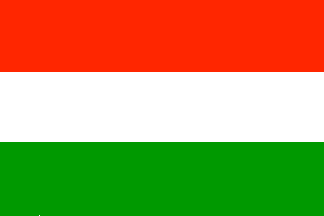 image by Ivan Sache, 13
September 2022
image by Ivan Sache, 13
September 2022
I.E. Juan Bautista La Salle is located in Florencia (department of Caquetá.
The flag of I.E. Juan Bautista La Salle is horizontally divided
red-white-green.
Red is a symbol of force, dynamism and glee experienced in
the school.
White represents purity, safe coexistence and peace taught to
students.
Green represents hope and daily cultivation of knowledge to be
cared for and preserved.
https://juanblasalle.edu.co/index.php/nuestra-institucion/simbolos-institucionales
- School website
Ivan Sache, 13 September 2022
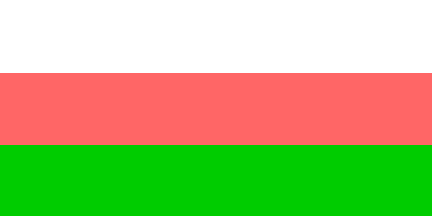 image by Ivan Sache, 11 August 2014
image by Ivan Sache, 11 August 2014
Institución Educativa Juan de Cabrera was established by Agreement No. 9 of
26 April 1961 on the Tres Esquinas estate, then owned by Max Duque Gomez in the
San Martín borough, part of the municipality of Nieva (Huila Department). The
institute is named for Captain Juan de Cabrera, involved in the conquest of the
territories of the today's Cauca and Tolima Department. Cabrera was killed in
the battle of Añaquito, fought on 18 February 1546 during Gonzalo Pizarro's
insurrection.
The flag of the institute is horizontally divided white-pink-green.
Source:
http://institucioneducativajuandecabrera2011.blogspot.fr/p/simbolos.html -
Institute's website
Photos:
http://2.bp.blogspot.com/-A2ZIAqJ1JuY/U4CdgdkbndI/AAAAAAAABEI/qawc1ZFHa-A/s1600/DSC00032.JPG
http://3.bp.blogspot.com/-prH6GUEc3LM/UiVQYfYJQcI/AAAAAAAAAz4/YbZNeyIYAm4/s1600/DSC01257.JPG
http://1.bp.blogspot.com/-rWch1wvhp7E/UiVQYHb_cXI/AAAAAAAAAz0/VXQLyIyhet4/s1600/DSC01259.JPG
http://1.bp.blogspot.com/-usjoz7c3ipg/UiVTMc_dDqI/AAAAAAAAA0w/KN_2AfndZX0/s1600/DSC01299.JPG
http://2.bp.blogspot.com/-YkCTmh7C_ys/UiVUF-J43lI/AAAAAAAAA1E/qzCwHJpbNI4/s1600/DSC01307.JPG
http://3.bp.blogspot.com/-yOhXEcnJkQE/UiVJw56WRoI/AAAAAAAAAy8/imdfy0D6Wtc/s1600/DSC01080.JPG
http://3.bp.blogspot.com/-_X36wJ9UdhY/TzcNt3hotXI/AAAAAAAAAes/PVPn44o2WFk/s1600/DSC00011.JPG
Ivan Sache, 11 August 2014
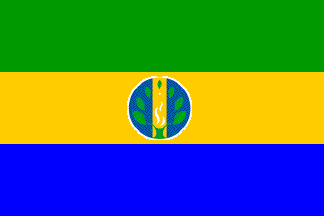 image by Ivan Sache, 09 November 2014
image by Ivan Sache, 09 November 2014
Instituto Catequístico Juan de Castellanos was established in 1967 in Tunja
(Boyacá Department) by His Grace Ángel María Ocampo Berrío, (1897-1991; 1st
Archbishop of Tunja, 1964-1970), giving an official status to classes initiated
in 1963 by the Daughters of the Church and Father Álvaro Castillo Dueñas.
Instituto Catequístico para Educación Superior was established on 27 April 1985
and renamed Instituto Universitario Juan de Castellanos in 1989. Fundación
Universitaria Juan de Castellanos was eventually established by State Resolution
No. 1,904 of 5 August 2002.
The institute is named for the Spanish priest, poet and soldier Juan de
Castellanos (1522-1607). Ordained in Cartagena, Castellanos was appointed parish
priest in Tunja, where he composed his masterpiece, the epic poem "Elegias de
Varones ilustres de Indias", the longest epos ever written in Spanish and a
vivid account of the Spanish colonization of Colombia and Venezuela.
The flag of the institute is horizontally divided green-yellow-blue with the
institute's emblem in the middle. Yellow is a symbol of light, intellect, faith,
and kindness. In the Christian religion, yellow is the symbol of divinity. In
heraldry, or is a symbol of nobleness, splendour, prosperity, magnanimity,
constancy, wealth, power, and light. Green is a symbol of growth, renovation,
and natural environment. In the Christian religion, green is a symbol of life.
In heraldry, vert is a symbol of hope, faith, friendship, commitment, and
respect. It is a symbol of greatness, highness, asylum, and safeguard. Blue is
associated with spirit and intellect, as a symbol of truth, transparency,
loyalty, fidelity, constancy, and chastity; it is also the colour of the sky
that represents immensity and eternity. In the Christian religion, blue is a
symbol of truth. In heraldry, azure is a symbol of air, justice, obedience,
loyalty, piety, and prudence.
The emblem of the institute features;
- a flame, as a symbol of divine illumination of spirit and purification, of the
Holy Ghost, and of knowledge provided by God;
- a tree, as a symbol of life, immortality, knowledge, stability, and growth. In
heraldry, the tree is a symbol of stability and love in valuable enterprises.
The green colour of the leaves is a symbol of growth, renovation, and natural
environment;
- a star, as a symbol of divine guidance and constancy. The five-pointed stars
specifically represents the Bethlehem star that guided the King Magi; the
pentagram also represents the human being and science (astronomy);
- organic forms, as a symbol of the natural environment and harmony provided by
God; the leaves pointing upwards increases growth and projection towards future;
- a circle, as a symbol of totality, original perfection, infinity, eternity,
perpetual movement, and life cycle. It is also the symbol of God. In heraldry,
the oval shape indicates the clerical personality of the one who bears it. The
blue colour of the disk is associated with spirit and intellect;
- a golden yellow stripe, as a symbol of light provided by God and illuminating
knowledge. Yellow is a symbol of light, intellect, faith, and kindness;
- a cross, as a symbol of communication between God and the earth, representing
the tree of life and birth. It also symbolizes the archetypal man able to
harmonize celestial, intellectual, spiritual, and active components with
terrestrial, rational, and positive components. In the Christian religion, the
cross is the central symbol of hope, of relationship, faith, and salvation
through Jesus' sacrifice.
Source:
http://www.jdc.edu.co/nosotros/información-general/simbologia-institucional
- Institute's website
Ivan Sache, 09 November 2014
 image by Ivan Sache, 1 January 2021
image by Ivan Sache, 1 January 2021
Escuela Juan de la Cruz Posada was established in Medellín by Decree No. 158
issued on 20 January 1962. The school was merged in 1980 with Escuela República
del Ecuador. IE Juan de la Cruz Posada was established by Resolution No. 92-78
issued on 26 November 2001.
The flag of IE Juan de la Cruz Posada is
vertically divided celestial blue-white-red with the school's coat of arms in
the center.
Blue represents calm required to solve conflicts.
White
represents the purity of heart, kindness, service and transparency.
Red
represents vigor, energy, tenacity and work.
The shield is surmounted by
a scroll inscribed with "CIENCIA Y VALORES" (Science and Values". The shield is
surrounded in its lower part by another scroll inscribed with the school's name.
The upper left part is blue, charged with an owl, as a symbol of knowledge and
culture. The owl stands on two books, representing research and education.
The central part is white, symbolizing gallantry and deepness. The hands offered
to God and to the service of man represent building, sowing, prayer, blessing,
search for truth... The candle indicating life on the road of existence is
inscribed with the Greek letters Α and Ω, recalling that everything has a start
and an end. The candle is burning, providing heath to the hands expressing
humility and love for God.
The upper right stripe is red, charged with two
crossed axes, as a symbol of constant work.
https://ediandres6.wixsite.com/clases/nuestro-colegio
School website
Ivan Sache,
1 January 2021
 image by Ivan Sache, 1 August 2018
image by Ivan Sache, 1 August 2018
Ateneo Juan Eudes was established in 1979 in borough Minuto de Dios, Bogotá
by the Eudist fathers Rafael García-Herreros and Luís Alberto Arbeláez, Rector
of Colegio Minuto de Dios, and Susana García. The school was aimed to students
who had lost a year.
http://www.colegiosminutodedios.edu.co/ateneo-juan-eudes/index.php -
Institute's website
The institute is named for St. John Eudes (1601-1680,
canonized on 31 May 1925 by Pope Pius XI), a French missionary who established
in 1673 the Eudist congregation (Congregation of Jesus and Mary).
http://www.newadvent.org/cathen/05596a.htm - Complete biography, The
Catholic Encyclopaedia
The flag of the institute is horizontally divided
white-orange with the institute's emblem in the center. The emblem is made of
the orange stylized, interlaced letters "AJE", surrounded by two blue rings.
http://www.colegiosminutodedios.edu.co/ateneo-juan-eudes/index.php/quienes-somos/nosotros/simbolos
- Institute's website
Ivan Sache, 10 March 2017
See also: San Juan Eudes, Colegio
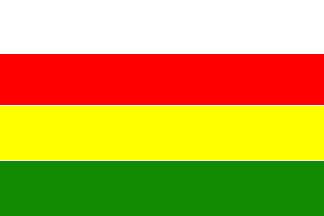 image by Ivan Sache, 12 December 2020
image by Ivan Sache, 12 December 2020
Colegio Distrital Juan Evangelista Gómez (CDJEG) was established in Bogotá by
Agreement No. 11 issued on 25 February 1983.
The flag of CDJEG is
horizontally divided white-red-yellow-green.
https://www.juanevangelistagomez.edu.co/nuestro-colegio/simbolos
School
website
Ivan Sache, 12 December 2020
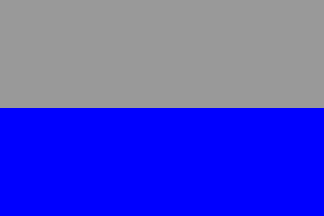 image by Ivan Sache, 18 September 2014
image by Ivan Sache, 18 September 2014
Escuela Normal Juan Ladrilleros was established in Buenaventura (Valle
Department) by State Law No. 166 of 30 November 1956. His Grace Gerardo Valencia
Cano, Apostolic Vicar of Buenaventura (1953-1972), was appointed first director
of the school; he commissioned the Tertiary Capuchin Sisters of the Holy Family,
a congregation founded on 27 April 1885 by Luis José María Amigó y Ferrer
(1854-1934), to manage the school. The church of Buenaventura would rule the
school until 31 December 1975, when it was transferred to the Ministry of
National Education, as prescribed by the concordat signed in 1973. The school
was renamed Escuela Normal Superior Juan Ladrilleros by Resolution No. 3,492 of
24 December 1999. Institución Educativa Escuela Normal Superior was eventually
established in 2002 as the merger of Escuela Normal Superior Juan Ladrilleros
and of Centro Docente Olímpico No. 120. The institute is named for Juan
Ladrilleros (c. 1490-1559), who founded in 1540 the town of Buenaventura.
The flag of the institute, designed by Sister Libia Esther Vásquez Gutiérrez,
Director of the school from 1962 to 1972, is horizontally divided silver
gray-blue. Gray is a symbol of equity. Blue is a symbol of the deepness of not
only the heavens and the mountains, but also of science and human nature.
Source:
http://www.ienormaljuanla.edu.co/documentos/HISTORIA.pdf - Institute's
website
Ivan Sache, 18 September 2014
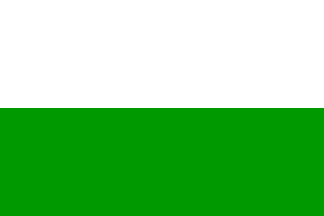 image by Ivan Sache, 20 November 2014
image by Ivan Sache, 20 November 2014
Institución Educativa Técnica Juan Lasso de la Vega is located in Valle de
San Juan (Tolima Department).
The flag of the institute is horizontally divided white-green.
Source:
http://juanlassodelavega.wordpress.com/ - Institute's website
Ivan Sache, 20 November 2014
"Colegio 'Juan Lozano y Lozano'" was founded in 1984
in Bogotá. The institute is named after the poet, diplomat and
journalist Juan Lozano y Lozano (1902-1980).
The flag of the institute, according to a photo and the description
available on the website
of the institute, is red with the emblem of the institute in
the middle.
The emblem shown on the flag shows some differences with the
emblem shown graphically on the website of the institute. It is
made of a yellow triangle charged with stylized black letters
"JLL" and inscribed in a white disk. The red border of
the disk bears the black writing "COLEGIO DISTRITAL"
(top) / "JUNA LOZANO Y LOZANO" (bottom). There is
something written in black under the triangle, ending with
"...ITUD".
The emblem shown on the website has the white writing
"INSTITUCION EDUCATIVA DISTRITAL / JUAN LOZANO Y
LOZANO" and nothing written under the triangle. Therefore,
it seems that the flag was not "updated" when the
satutes and name of the institute were changed.
Ivan Sache, 17 January 2009